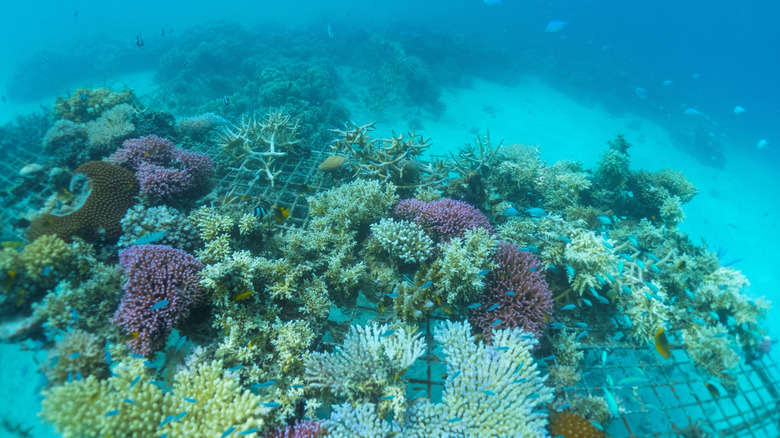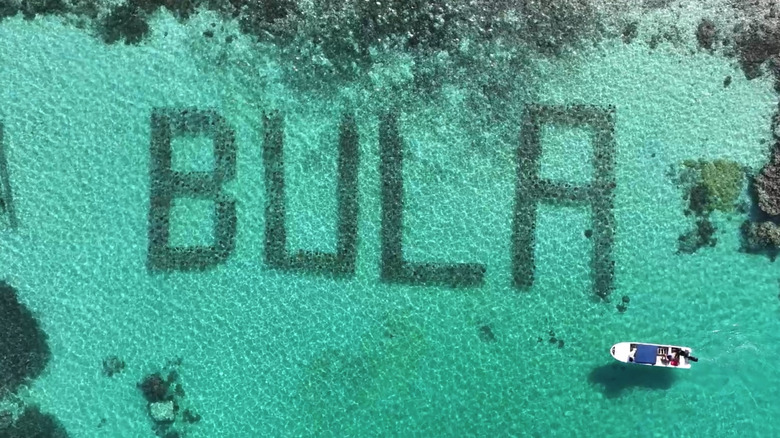Fiji's Human-Made Reef Of Heat-Adapted 'Super Corals' Is An Astonishing Wonder You Can Snorkel
One only needs to turn on the news to see the havoc climate change is wreaking on communities all over the world. In 2024 alone, there were more than 150 unprecedented extreme weather events — these include flash floods in Pakistan, heatwaves in Japan, and tropical storms across Southeast Asia with villain-esque names like Super Typhoon Yagi. As the threat of more destructive disasters looms ever closer, many feel anxiety around the issue. There's a sense of inevitability, which has even led to the "last chance tourism" trend, where travelers aim to get a farewell tour of glaciers and reefs before they disappear. Fiji, like many other Pacific islands, is particularly vulnerable to climate-related natural disasters like cyclones, landslides, and floods. If these continue unmitigated, Fiji may become yet another one of the iconic destinations slowly being destroyed by climate change. But while many throw up their hands in despair, others put their heads down and work to find solutions. It is here, on this fragile yet biodiversity-rich island, that a unique conservation strategy is taking place.
Reefs of Hope is a collaboration between Plantation Island Resort and Fijian non-profit organization Corals for Conservation, founded by marine scientist Dr. Austin Bowden-Kerby. After 10 months of labor, the team unveiled its inaugural project: BULA Reef, an astonishing human-made wonder in the waters just off the resort. This UNESCO-endorsed coral nursery is where heat-adapted "super corals" are taken to grow and thrive in deeper, cooler waters. They are placed along massive elevated installations that together spell out the word "BULA," which means "life" in Fijian and is also a common greeting in the country. This 52-foot-tall, 147-foot-long, coral-covered structure was presented on June 8, 2024, to coincide with World Ocean Day.
BULA Reef and how it works
Unfortunately, during heatwave-induced mass bleaching events around Fiji, tens of thousands of corals were destroyed. Dr. Bowden-Kerby's team worked to collect the survivors of these events — the climate-resilient wonders that are key to reef restoration. They're known as "super corals," and they have weathered temperatures of up to 100 degrees Fahrenheit, demonstrating a tolerance for higher heat and an ability to recover from stress — a necessary adaptation for the future of corals, as the oceans continue to warm. As of June 2025, they saved almost 2,000 coral colonies, removing them from hot pockets in the shallows of Malolo and placing them on the wire-mesh platforms of the BULA Reef nursery. And once the corals are deemed ready to survive on their own, they'll be transported to the nearby Great Sea Reef, where they can (hopefully) thrive independently.
BULA Reef offers many benefits beyond simply saving super corals. Working to grow new colonies, replant struggling coral, and remove threats to the reef, while also sharing their work with incoming tourists, creates economic opportunities for local islanders. And as these "rainforests of the sea" continue to grow, they provide shelter and food for a diverse array of marine life. Additionally, they protect coastal villages and the shoreline itself from natural disasters. This special project is not only profoundly important — it's also record-breaking: BULA is the largest rescue reef ever. It's the biggest word written underwater (and written using corals). It's the first in what will likely be multiple projects under the Reefs of Hope umbrella, which has in itself also set a record as the only coral-focused climate-adaptation program endorsed by a UN agency. The hope is that this approach can be replicated across Fiji and other Pacific islands that are equally vulnerable to climate disasters.
How to see the BULA Reef
Plantation Island Resort, where the reef is located, can be found off the island of Malolo Lailai, west of the Fijian mainland. Malolo Lailai is part of the Mamanuca chain, some of the best Fiji islands to visit. To reach the hotel, fly into Nadi International Airport. As of this writing, there are four direct flights from the U.S. operated by Fiji Airways, departing from Honolulu (HNL), San Francisco (SFO), Dallas-Fort Worth (DFW), and Los Angeles (LAX). From the airport, you can arrange a transfer on a Malolo Cat, a high-speed catamaran, with the resort. Adult fare is $93 for a return trip, and it includes a coach transfer between the airport and Port Denarau Marina, from where the boat departs.
Of course, snorkeling is one of the most incredible things to do in Fiji, so you'll want to get underwater as soon as you arrive. Dulcinea Charters, which operates out of the resort, offers weekly guided snorkeling tours of the BULA Reef nursery. The tour lasts 70 minutes and includes two 20-minute snorkels around the nursery area with knowledgeable guides. Look out for a variety of marine species, including parrotfish and damselfish, along with vibrant, healthy coral of all types and hues. You can reserve your spot at the resort's booking office. It costs $11 and requires a minimum of four adults to run.
Back on land, you can take part in a variety of educational guest activities to learn more about coral conservation and restoration. Help plant coral onto structures, which will later be placed in the BULA reef. Create a fish house from cement and stones. And if you're traveling with children, enjoy a kid-friendly marine conservation talk, where the whole family can learn how to protect the environment.


